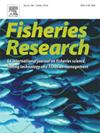Using otolith δ18O to assess habitat selection and growth in young-of-the-year Arctic charr
IF 2.2
2区 农林科学
Q2 FISHERIES
引用次数: 0
Abstract
Otoliths from young-of-the-year Arctic charr, captured between 1983 and 85 in the Ikarut River, Labrador, were used to determine thermal habitat use and the applicability of the ideal free distribution model as a description of the distribution of individuals between warmer and cooler water habitats. Across the growing season, otolith-derived temperatures tended to exceed river temperatures monitored at 1 m depth, indicating a preferential use of warmer waters. By the end of the growing season two thermal strategies were evident, use of warmer and cooler habitats as reflected in otolith-estimated mean thermal habitat use. There were no differences in proxy measures of fitness resulting from the different thermal habitats, suggesting young-of-the-year distributed themselves among heterogeneous thermal habitats in a manner consistent with the ideal free distribution. Results were also consistent with theories of habitat selection where individuals minimize the predation-foraging gain ratio via the “asset protection principle” suggesting that many Arctic charr maximize growth efficiency rather than growth rate. Either model suggests behavioural bias in otolith-derived estimates of thermal environments, requiring that derived temperatures must be interpreted with caution when used to infer historical conditions as they represent the portion of the habitat used and are not general indicators of environmental conditions. Nevertheless, studies of otolith temperatures provide important ecological insights into the use of available thermal habitat and point to patterns of behaviour which may become constrained as environments change.
求助全文
约1分钟内获得全文
求助全文
来源期刊

Fisheries Research
农林科学-渔业
CiteScore
4.50
自引率
16.70%
发文量
294
审稿时长
15 weeks
期刊介绍:
This journal provides an international forum for the publication of papers in the areas of fisheries science, fishing technology, fisheries management and relevant socio-economics. The scope covers fisheries in salt, brackish and freshwater systems, and all aspects of associated ecology, environmental aspects of fisheries, and economics. Both theoretical and practical papers are acceptable, including laboratory and field experimental studies relevant to fisheries. Papers on the conservation of exploitable living resources are welcome. Review and Viewpoint articles are also published. As the specified areas inevitably impinge on and interrelate with each other, the approach of the journal is multidisciplinary, and authors are encouraged to emphasise the relevance of their own work to that of other disciplines. The journal is intended for fisheries scientists, biological oceanographers, gear technologists, economists, managers, administrators, policy makers and legislators.
 求助内容:
求助内容: 应助结果提醒方式:
应助结果提醒方式:


